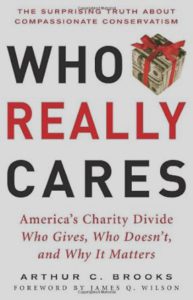Who Really Cares: America’s Charity Divided by Arthur Brooks

Nathan Mayo
Director of Member Services
Read more from Nathan
Jump to:
The Purpose of the Book | The Perspective | The Key Points | Details We Love | Considerations | Who Should Read This?

This book can be purchased on Amazon.com.
In Who Really Cares: America’s Charity Divide, Arthur Brooks sets out to answer three questions: who gives, who doesn’t, and why does it matter? America is by far the most generous nation in the world – both in percentage of income financial giving and non-monetary contributions like volunteer time and organ donation. However, the high American average obscures the fact that there are two separate groups of Americans – some who give a lot, and some who give hardly at all. Brook’s findings show who these two groups are and provide inspiration and challenge to charity leaders and regular Americans alike.
Brooks’ tone is one of unification around common American values. His guarded optimism finds opportunities for unity in an era of division. Brooks lets the data drive his narrative – his work is garnished with anecdotes, but they never substitute for meatier facts. His approach is open-minded – he points out that the facts about charitable giving align neither with public perception nor his pre-existing opinions.
Brooks points out a significant charity divide between givers and non-givers in our society. The givers give both formally and informally of their time and money – the non-givers are stingy across the board. The givers and non-givers are not reliably segmented by race, income, gender, or party affiliation. However, there are four key factors that determine someone’s likelihood of being a giver.
1) Religious people are givers: Religious observance is a key predictor of generosity. People who attend church weekly are 25 percentage points more likely to give money and 23 points more likely to volunteer than people who rarely attend. They give 350% more money and volunteer 200% more time despite not having higher household incomes. Notably, this giving was not just to religious charities and causes; their support of entirely secular charities and voluntary associations is also comparably higher. Additionally, this factor transcends simple partisanship, secular conservatives are slightly less generous than secular liberals.
2) People who oppose government redistribution are givers: People who think the government should redistribute more income to the poor are significantly less likely to give to the poor themselves. Even adjusting for income and all other factors, their fervent belief that the government should do more diminishes the likelihood that they give to charity by 10 percentage points (they volunteer less as well). This effect gets even stronger when combined with religiosity. A person who goes to church every week and strongly opposes government redistribution will give 100 times more to charity than a secularist who strongly supports redistribution – the churchgoer will give 50 times more to non-religious charities as well.
3) The working class is the giving class: Unsurprisingly, families with a net worth of over one million dollars give about half of all charitable contributions. However, in terms of percentage of income, the poor are more generous than the rich or middle class. The poor do not all give at the same rates. Among similar families with the same annual income, welfare recipients are 300% less likely to donate their time and money than their working counterparts. Working poverty is correlated with generosity; welfare poverty is correlated with selfishness.
4) Strong families are givers: Married parents are more likely to give to charity and volunteer than non-parent couples with similar incomes. This may seem odd at first, because kids are expensive and time consuming, but since parenting is itself a charitable act, it stands to reason that people who choose to parent are more likely to give in other ways as well. Generous parents also raise generous kids – parental modeling is a good predictor of how giving kids will be later in life. Additionally, people are also more generous with inherited money than with earned income.
The final point that Brooks makes is that charity is good for the givers. From both statistical observation and controlled trials, charity seems to make the giver happier, healthier, wealthier and more civically engaged. For this reason, a world in which the government provides for all the needs of the poor is not only worse for the poor, but for the rest of us as well.
Brooks opens with the idea that charity must be consensual and beneficial. Brooks gives the example of a homeless man. If he forces his way into your home, that’s breaking and entering. If you hold him there against his will, that’s kidnapping. If you invite him to stay and he accepts, that’s charity. This definition of the voluntary nature of charity feeds our core belief that authentic charity is voluntarily resourced – not merely compelled by the government. As Brooks evidences, this voluntary sort is much better for all parties involved. Brooks also shows a significant crowd-out effect of private charity from additional government giving. We agree with his assertion that non-profits who rely entirely on government grants are failing to have the broad social impact that they could. Charity is good for people, and charities have a responsibility to facilitate it for both givers and recipients.
Who Really Cares doesn’t address the effect of charitable giving. Brooks points out that religious people are far more likely to give money to panhandlers and it makes givers feel good. That tells us nothing about what it does for the panhandler – it most likely feeds an addiction. Charitable intent is important, but it’s not all that matters. Also, we should note that this book is now over a decade old, so some of the numbers might have changed slightly. Overall, the book still feels very current and the aging provides this work with the credibility of seeing some of its predictions come to pass.
This book helps readers grasp a detailed picture of the importance charity plays in our society, who upholds it, and how we can further it. It can provide good insights and inspiration to non-profit leaders and anyone interested in what makes American givers get behind your work.
 Who Really Cares can be purchased at Amazon. If you purchase the book through this link, True Charity will earn a small amount as an Amazon Associate
Who Really Cares can be purchased at Amazon. If you purchase the book through this link, True Charity will earn a small amount as an Amazon Associate
This article is just the tip of the iceberg for the practical resources available through the True Charity Network. Check out all of the ways the network can help you learn, connect, and influence here.
Already a member? Access your resources in the member portal.





